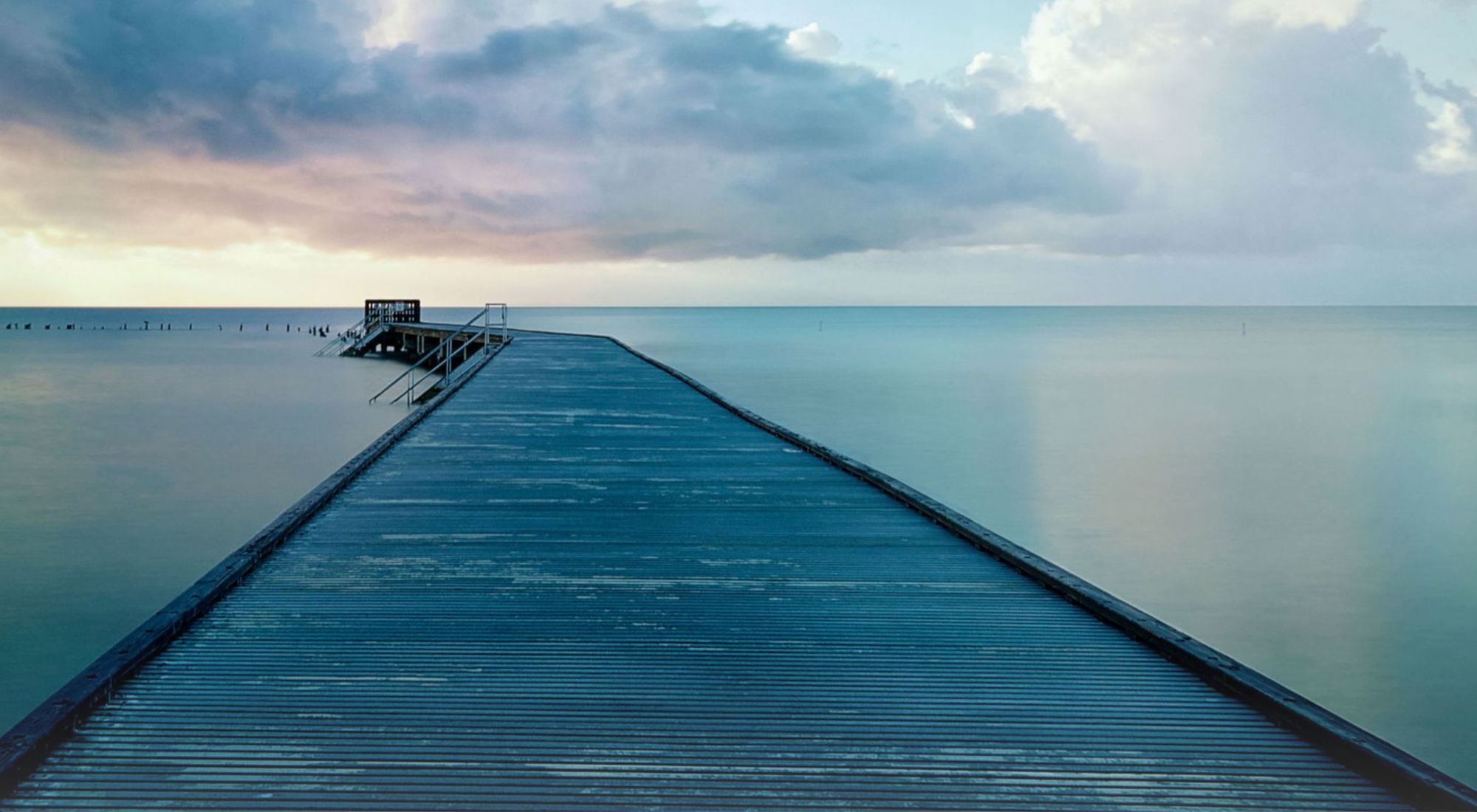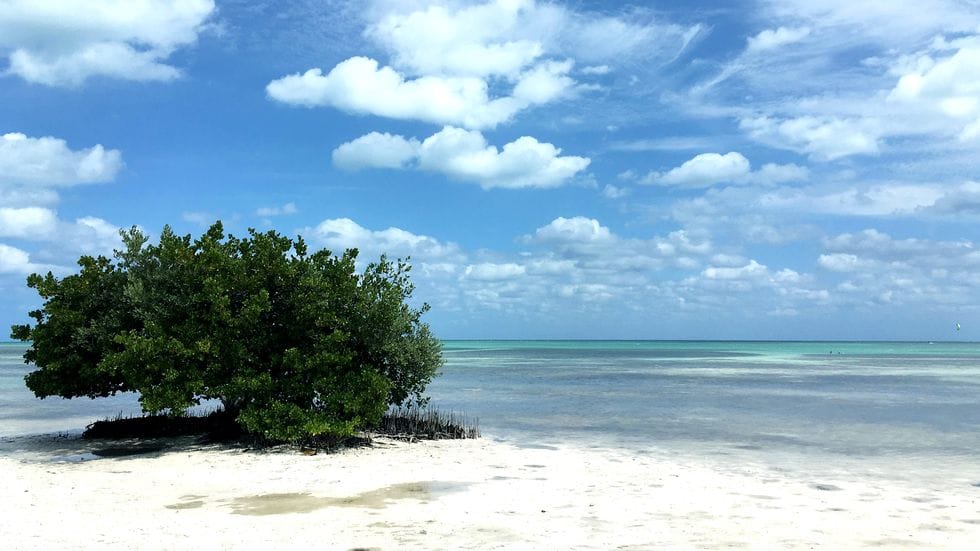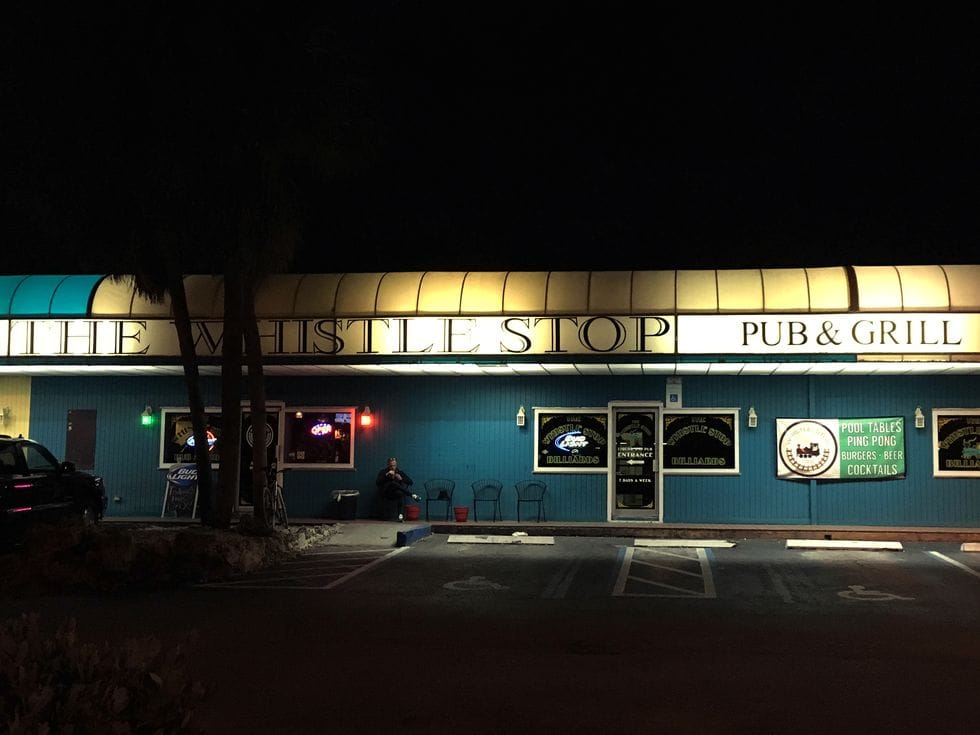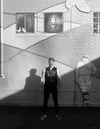Searching the Sunny Florida Keys for Netflix's Darkest Show

This piece was originally published in Esquire in 2016.
When you raise kids here, it's all about the water," our captain said. We'd just launched from the marina at The Stoned Crab in Key West, and Tony Osborn, the co-owner of the restaurant and the adjacent Ibis Bay Resort, had agreed to show us a part of the Keys that you don't normally see—to pull back the curtain of the well-trod cavalcade of Duval Street's galleries, dives, and t-shirt shacks. He piloted the 19-foot boat close to the shore. It was an exceptionally windy day, so there weren't many others on the water as we passed Dredgers Key and the Gulf of Mexico to our port side. With such choppy waters, Osborn wouldn't want to pull crab traps as he normally might; the boat could tip with the weight. Besides, not much fishing goes on in the immediate vicinity, Osborn explained, since the water is too shallow for anything but stingrays or sharks. Noticing our apprehension, he tried to reassure us. "The sharks won't bother you unless you're spearfishing," he said. "They smell that blood in the water."
We hewed close to the mainland for a long stretch, sputtering past the strip malls and palm tree-lined highway of Route 1, the road that leads from the southernmost tip of the Keys all the way to Miami, an endless loop of scooter rental shops, pancake restaurants, and brightly painted hotels. Before turning right up the Cow Key Channel heading toward the Atlantic side, we stopped to consider a giant iguana bobbing along in the falling tide, making his way toward the overpass, and scraping at the wall in a futile attempt to hoist himself out.
The night before we sat on the open air dock-side dining room of the Stoned Crab on another exceptionally windy day, and Osborn, who reminded us of Billy Bob Thornton's much nicer, suntanned brother, was explaining his transition into the hospitality business, and his family's ties to the ocean; much like for everyone else in the Florida Keys, it's a constant presence in their day-to-day lives.
My wife and I had traveled to the Keys for a number of a reasons: an escape from the lingering cold of the early Boston spring, a culinary tour of some of the region's restaurants and bars, and, as a sort of thematic guide map, a chance to explore some of the indelible sets and scenery of one of our current favorite shows, Netflix's familial-noir series Bloodline, the second season of which premiered on the streaming platform last week. We would travel to Islamorada a couple of days later, where much of the series is filmed, but, without even meaning to, Osborn was already drawing parallels between the series and the world of the Keys for us.
His restaurant and resort, in New Town Key West, a more commercial, suburban-feeling area than the boho and bobo charm of Old Town where we were staying (at the shady, calm, bucolic oasis of the Gardens Hotel), differs in kind and scope from the fictional Rayburn House on Bloodline, but the ties to the sea are no less paramount. The focus, like everywhere else around here, is seafood, but his restaurant is different, Osborn said, in that he and his sons catch about 80% of what they serve. Keeping the distance between dock to dish as short as possible is the philosophy behind their "Three Hands" motto: from fisherman, to restaurant, and diner. And here, the fresh quality is evident, with chef Paul Menta—also the distiller of the fine Key West Legal Rum, the first legal distillery in Key West, whose product we'd become rather familiar with this week—serving an array of snapper, hogfish, lion fish, grouper, mahi mahi, barrel fish, and stone crab.
In the past there's been conflict between fish houses and fisherman, Osborn explained over a towering pile of lobster and stone crab, over-sized oysters, plantains, and succulent yellowtail snapper, while instructing us in the proper technique for de-shelling Key West head-on pink peel shrimp (leaving the head on while cooking heightens the flavors in the natural oils). "We're trying to start a revolution here, combatting the promotion of imported seafood," he said. It sounds insane, but somewhere in the vicinity of 96% of what Americans consume is imported seafood, while we in turn export 80% of what's locally caught. That's largely because we don't want to pay the premium cost for fish that comes from close to home.
When that fish can be caught literally just outside your home, as is the case in much of the Keys, it makes sense that so many people, like the Osborns, would take advantage.
"Everyone here does a business and commercial fishes," he said. "The water is part of our life absolutely." For him and his children—including fisherman Alex—that meant growing up spear fishing, alligator hunting, hover boat rides in the Everglades on pig hunts. "My kids have been to other places, but they always seem to gravitate back here," he said, echoing the theme of Bloodline.
It was a slow, plodding trip, making our way out toward Boca Chica Key, where Osborn wanted to show us a sandbar perfect for swimming, just off the coast of a busy Naval Air Station. We passed by the local jail, with beautiful views overlooking the water. "Waterfront property," he joked. "Even going to jail's not bad here."
Along the floor of the shallows, sea-sponges were in abundance. Around 100 years ago, they were the most valuable fishery in all of Florida, with around 600,000 pounds produced annually. Today it's a tenth of that. The Japanese were one of the chief markets, utilizing them for a number of medical uses, including their natural ability to soak up blood.
Turning up around the Keys, northwest, he brought the boat to a stall. "Look there," he said. A dark shape bobbed just beneath the surface, in waters clear enough to see through, but roiling enough to obscure the visage. We trailed the fish for a while, heading it off to get a better look. My wife and I leaned in closer, and before he could even explain what it was, I felt it announce itself. "That's a 350 pound bull shark," Osborn said. Having never seen a dangerous shark in the wild before, its liquid, primal energy was visceral. I am not cut out for life on the water, I thought.
Although we traveled a few miles away in the opposite direction from the shark, our swim on the sandbar was fraught with anxiety. Another stop, to snorkel in the shallows near a mangrove outcropping, was similarly nerve wracking. Along these outgrowths you might find mud piles four or five feet high, and see little caves in the mud with antenna sticking out. That's partly how they find their lobsters here. The gnarled branches of the saltwater trees, jutting out of the water, growing over one another, brought to mind a scene from Bloodline. This would be a good place to lose a body, I thought. A heron burst forth from the bushes as I swam determinedly back to the boat. Overhead fighter jets roared in the sky, coming and going from the nearby naval base, their lethal power a mirror image of the shark whose presence I couldn't shake.
If you've seen Bloodline, or read anything about the show, it's a commonplace to refer to the setting as one of the main characters. And that's saying a lot, considering the bravado performances of the cast, including Kyle Chandler and Ben Mendelsohn in particular, the elder two brothers of the equally charmed and cursed Rayburn clan.

"Bloodline has the sort of atmosphere you shouldn't put a price tag on," TV critic Andy Greenwald wrote of its premiere last spring. "A warm breeze ripples through every frame, rustling the palm trees and the salt-sticky hair of locals. Cicadas chirp loudly underfoot, unseen lizards skitter through the mangroves. The sun, high in the sky, radiates an impossibly bright whiteness. It's a natural spotlight that exposes as much as it dazzles. Anything is possible. Everything is visible."
He's exactly right—except for that last part. Everything isn't visible, and, as in any good noir series, it's the things floating right under the surface, just out of our view, that are the most dangerous. That's a dynamic that's hard to ignore anywhere in the Keys, but particularly in Key West, a place where the painterly sunset is treated like the red carpet premiere of a movie each night. (Dinner beachside at Latitudes on Sunset Key, a short ferry ride away, being one of the best vantages to take it).
Little filming for the show was done here, but its soul is present nonetheless. It's an effortlessly charming maritime city, with an exceptionally rich history in naval trade (around the turn of the last century, it was the biggest and richest city in Florida), art and literature (the Hemingway House is a tourist trap of sorts, but worth the visit anyway), cuisine, and, of course, drinking. For a city with a population of 25,000, there are around 360 liquor licenses—roughly one bar per 70 people. (Among the best is the cutting edge cocktail outpost Caroline's Other Side, a little slice of urban cool amidst the relaxed pastel sea air.)
"Alcoholism down here is crazy," a friend told us, over, of course, multiple Moscow Mules at 2¢ Restaurant just off of Duval Street, the main thoroughfare of Key West, the vibe of which is sort of Bourbon Street debauchery meets Provincetown history. There are three types of people here, he explained: the rich-as-hell, the service industry, and the bubbas.
The character of Danny Rayburn (played by Emmy nominee Ben Mendelsohn) is something of a mix of all three, and he's a type that abounds throughout the Keys.
"I've met a lot of Dannys," Jeff Riley, a professor at Florida Gulf University, told me when I asked about the veracity of the show's depiction of the region. "No piece of visual pop culture has ever properly and truthfully represented south-Florida dirtbag as well as that show. Danny is the most authentic character representing an archetype of not just the Keys, but of south-Florida in general. The show follows in the footsteps of a lot of great south-Florida crime novels that helped evolve the criminal trope from Scarface-esque gangster to dirtbag in the corner of the bar who starts asking people if he can borrow a couple of pain pills to get him through the weekend."
It's not hard to imagine a Danny (or his friend and fellow ne'er-do-well Eric O'Bannon, played by Jamie McShane), haunting one of the many dives here, from the iconic and boisterous Green Parrot or Willie T's; every inch of the latter is covered in dollar bills stapled to the ceilings and walls. But for a better picture of the world of Bloodline and the Keys in general, one needs to head north. We rented a Mustang convertible, which seems to be the official rental of choice around here (and appropriately ridiculous). We struggled to even figure out how to turn it on—never mind lower the roof. But it was a choice that paid off, as the road from Key West to Islamorada, where the chief filming takes place, was every bit as scenic as the overhead shots of the Florida Overseas Highway in the opening credits make it look.
Along the drive there was so much vivid greens and blues exploding from every angle, it was hard to focus on any one thing to look at. The highway is a massive project that connects the keys, hopscotching from island to island, in an engineering marvel that we may take for granted, but seems like it almost shouldn't exist. We wound through deer refuges, and salty marshes, the smell of the ocean ever present, the azure palate blinding. Natural marvels aside, this being a well-travelled commercial highway, the roadside scenery was almost as uncanny. The only thing more plentiful than t-shirt shops and gun and liquor stores along the way were the swarms of butterflies.
About an hour and a half north, on the Lower Matecumbe Key, Anne's Beach was an inviting respite from the drive. You might recognize the beach from Robert Rayburn's kayaking excursions, and it's not hard to see why he might choose this locale. Of course it's nowhere near as isolated as it's made to look on the show, although a line of trees, bent by the wind and yearning toward the ocean, serves as a barrier from the highway, and a merciful relief from the sun. High-stepping herons patrolled the white clay shallows of low tide, while a kite boarder wrestled with the wind, the sky and the ocean blending into a smear of color making it hard to tell where one ended and the other began.
Nearby, Robbie's Marina, like much else here, tucked away amidst the twisting trees along the water, presented itself. Another popular stop along the highway, it was bustling with sun-soaked tourists availing themselves of kayak, Jet Ski, and snorkeling rentals. A number of scenes were shot here for the series, including prodigal son Danny's return home meeting with O'Bannon. Along the docks, teams of fishermen were hoisting a recent catch. Dozens of ravenous tarpons swarmed in the water below, conditioned to be fed. A fisherman de-skinned two-foot mahi, tossing the unwanted parts into the water, where the birds fought one another for a chance to gorge themselves in one violent gulp.
Further into Islamorada, we found the Cheeca Lodge and Spa, a luxury resort that backs up to the Atlantic. A large complex of tennis courts, a golf course, swimming pools, and dense palms, it was used numerous times throughout the series, including a scene shot in the cemetery (here dedicated to the founders of Islamorada, not something you see often on a resort hotel beach admittedly) and the lengthy pier out back that served as the one dedicated to the Rayburns in the show. Walking out onto the pier, I was again struck by the magic of camera perspective. What appears to be a solitary stoic boat launch on film is actually adjacent to a gurgling pool lagoon, with guests sipping cocktails at an outdoor tiki bar.
It's admittedly a bit silly to be excited about visiting the locales of a TV show, but when it's one where every frame is so beautifully shot, and viscerally felt, the effect is like you've stepped into the realm of fiction that's different in kind than visiting oft-filmed locales in a city like Boston or New York. Just down the beach another pier loomed in the distance at the The Moorings Village & Spa, which serves as the home of the Rayburn House on the show. It seemed distant and unreachable. We'd try to get closer the next day, to see the Rayburn compound proper, before heading north to Miami, but they were strict about letting anyone who wasn't staying on the property—which is exceptionally pricey, and, seemingly, worth it—get too close. "People pay for the privacy here," the attendant at the front desk told us of the series of private bungalows tucked into a thorny canopy of trees. You wouldn't even notice it was there if you weren't looking closely enough.
If there's anything that Bloodline succeeds at better than showcasing the beauty of the Keys, it's highlighting the omnipresence of drinking. Scarcely a scene goes by without one character or another reaching into the fridge to open a beer, and much of Danny's plotting and revelry takes place in many of the numerous dive bars and seaside watering holes of Islamorada and Key Largo, like Alabama Jack's, Caribbean Club, Ocean View Inn and Pub, Morada Bay, the Whistle Stop Bar, Mangrove Mike's Cafe, and the Safari Lounge.

Michael, our driver, was well versed in all of them, which was fortunate, since he was literally the only Uber operating in the area.
We stopped first at Marker 88, a waterfront restaurant and bar with splendid views of the sunset. We drank Islamorada Ale, brewed just up the street, and dug into lobster guacamole and conch chowder—both ubiquitous around here—while a band played the Kinks. "Lazing on a sunny afternoon…" The restaurant should be recognizable to fans of the show as the setting of a portentous meeting between Danny and his father.
Everyone asks to sit in the seat in question, overlooking the water, the manager Barbara told us. Jamie McShane and Kyle Chandler are regulars now, she said. Like all of the other locals we talked to, she's effusive in her praise of the cast and crew. "It's awesome. Kyle and Jamie very good with people who come here, they're good with customers, and not arrogant. I love them."
A scene for the second season was filmed here as well she said, but she didn't catch any spoilers. They'd probably kill her if she shared one anyway, I joked.
"Oh yeah."
Michael ferried us to the Whistle Stop next, the site of Danny's debauched meltdown, where he picks a fight with a much larger man, and is thoroughly rewarded with the ass-kicking he was asking for. There's much that was accurate to the locale in Bloodline, he said, but he did find a few inconsistencies.
The rain is one bit of creative license, he said. It never happens here. "There's not enough landmass for it to gather over."
This being a region with an almost infinite number of secluded areas for boats to come and go, there's still very much a drug culture here. "Cocaine was like potato chips at a party" when he was growing up, he said. But it's not out in the open. "If they saw someone selling coke at a bar around here, they'd be locked up so fast."
But even Michael recognized the show's artistic licenses. "I saw [one episode] where [Danny Rayburn] was out partying all night long, doing meth and coke, then the next day he was out cleaning fish. How could you do anything like that?" He laughed. "Here in the summer it's 94 degrees at night!"
At the Whistle Stop, a pool hall and dive bar, locals played ping pong and slung back bottles of beer. I asked one woman what she thought of the show's portrayal of the area. "Yeah, there's drugs, because there's Cuban waters nearby," she replied. "Drug wise and fights wise, it has its moments. But it's a good town." In other words: We're not a bad town, we just do bad things sometimes.
In fact, last year, the Keys saw one of the most high profile crimes in many years. Carlos Ortiz and Tara Rosado were each shot once in the head while their children slept in the next room. It was the first double murder in the Keys since 1992. "We outdid the show," said the local at the Whistle Stop, who didn't want me to use her name. She didn't exactly relish the idea of talking about a drug-related murder to a reporter.
"There was a double murder over some cocaine found on boats," she continued. "It's funny because we have this super quiet town, then Bloodline comes, and that doesn't portray us. Everyone is so nice here. They're portraying Key Largo and Key West more. If it's about Key West, they're doing a great job."
She didn't think many around here watch the show besides to see locations they're familiar with—then to complain about the discrepancies. One scene might be set in Key Largo, then they walk somewhere and it's an entirely different area. The magic of film.
Behind us, a couple of young Rob Gronkowski types in training tossed darts underhanded, while a girl in non-existent shorts and her boyfriend, who had scraped off half of his face last night in a bike crash, tried to sneak in an underage friend. The bartender was killing it on the jukebox :"Season of the Witch" followed by "Don't Let Me Be Misunderstood."
We'd hit as many of the bars in the area as we could the next two days; the problem with a show set in so many bars is that it can really do a number on your ability to properly research them without falling over. Lorelei Restaurant & Cabana Bar was another favorite; if you look at pictures, it's not hard to see why.
Back at Cheeca that night, beaten by the sun and the fictional bar crawl, we laid on beach chairs in the gusting wind beneath towering palm trees. The low moon and clouds looked like a pattern stamped by the water into the clay of the beach. It was easy to lose your bearings. Down the beach, the pier outside Moorings was just visible in the moonlight. A beacon—or a warning.
